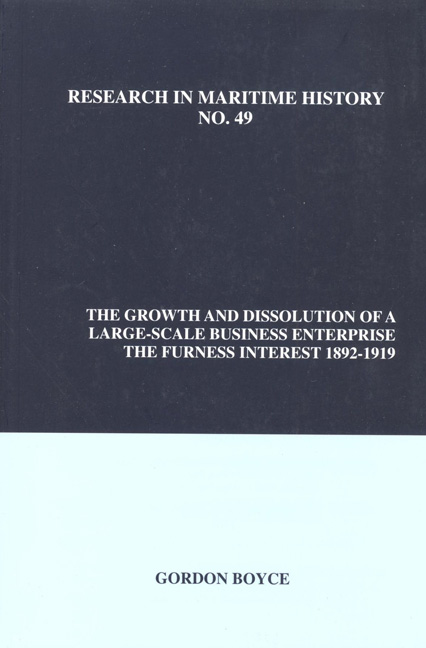Book contents
- Frontmatter
- Table of Contents
- About the Author
- Acknowledgements
- Figures and Tables
- Introduction
- Chapter 1 Furness' Shipping Services: Growth by Organic Means in the 1880s
- Chapter 2 The 1890s: Furness Withy's Expansion by Acquisition and Promotion
- Chapter 3 Diversification into the Industrial Sector, 1895-1901
- Chapter 4 Trouble on the Transatlantic Route: The Formation of the IMM and Furness' Response
- Chapter 5 The Growth of Shipping Services, 1902-1909
- Chapter 6 Industrial Operations and Performance, 1900-1914
- Chapter 7 The Growth of the Shipping Interests, 1910-1919
- Chapter 8 Structure
- Chapter 9 Finance
- Chapter 10 Holding Company Investment Activities and Intermediary Operations
- Chapter 11 Personnel
- Chapter 12 Furness
- Chapter 13 Dissolution
- Appendix 1 Development of the Combined Fleet, 1900-1919
- Appendix 2a Patterns of Ownership: The Furness Group, 1919
- Appendix 2b Reorganization of Branch Offices and Superintending Departments, 1911-1912
- Appendix 3a Fluctuations in Freights, Profits, Tonnage Afloat and Merchant Shipping Output
- Appendix 3b Output of Merchant Tonnage (Excluding Warships), 1892-1913
- Appendix 3c Fluctuations in the Price of a 7500-ton Cargo Steamer, 1898-1913
- Appendix 4 Development of the Furness Group: Principal Promotions, Acquisitions and Divestments, 1880-1919
- Appendix 5 Northern Allies and Maritime Associates
- Appendix 6 Contemporary Accounting Law and Conventions, 1845-1914
- Appendix 7 Lord Furness' Movements, 1899-1912
- Bibliography
Chapter 7 - The Growth of the Shipping Interests, 1910-1919
- Frontmatter
- Table of Contents
- About the Author
- Acknowledgements
- Figures and Tables
- Introduction
- Chapter 1 Furness' Shipping Services: Growth by Organic Means in the 1880s
- Chapter 2 The 1890s: Furness Withy's Expansion by Acquisition and Promotion
- Chapter 3 Diversification into the Industrial Sector, 1895-1901
- Chapter 4 Trouble on the Transatlantic Route: The Formation of the IMM and Furness' Response
- Chapter 5 The Growth of Shipping Services, 1902-1909
- Chapter 6 Industrial Operations and Performance, 1900-1914
- Chapter 7 The Growth of the Shipping Interests, 1910-1919
- Chapter 8 Structure
- Chapter 9 Finance
- Chapter 10 Holding Company Investment Activities and Intermediary Operations
- Chapter 11 Personnel
- Chapter 12 Furness
- Chapter 13 Dissolution
- Appendix 1 Development of the Combined Fleet, 1900-1919
- Appendix 2a Patterns of Ownership: The Furness Group, 1919
- Appendix 2b Reorganization of Branch Offices and Superintending Departments, 1911-1912
- Appendix 3a Fluctuations in Freights, Profits, Tonnage Afloat and Merchant Shipping Output
- Appendix 3b Output of Merchant Tonnage (Excluding Warships), 1892-1913
- Appendix 3c Fluctuations in the Price of a 7500-ton Cargo Steamer, 1898-1913
- Appendix 4 Development of the Furness Group: Principal Promotions, Acquisitions and Divestments, 1880-1919
- Appendix 5 Northern Allies and Maritime Associates
- Appendix 6 Contemporary Accounting Law and Conventions, 1845-1914
- Appendix 7 Lord Furness' Movements, 1899-1912
- Bibliography
Summary
A rise in world trade was the most important influence behind the improvement in freight rates and shipping values that began in 1910. From that year down to the last year of European peace, the value of the UK's foreign trade rose almost thirty percent, and shipping earnings grew by a similar amount. In 1910, freight rates rose slightly, but the upward movement gained momentum during 1911 and 1912 before falling off in 1913 as a downturn in trade and financial markets took place (appendix 3). In addition to favourable demand conditions, constraints on the supply of available tonnage provided additional impetus to the initial rise in 1910. The extremely low freight rates of the two preceding years, coupled with high insurance premiums, made it uneconomic to continue operating older vessels and led to a sharp increase in the number of ships sent to the breakers’ yards. In addition, the low number of new vessels that came onto the market in 1908 and 1909 caused the supply of tonnage to show virtually no increase for three years, 1907-1909; it was the first time this had occurred since the mid-1880s. Labour disturbances prevented output from catching up with demand and strengthened shipping values and rates.
This chapter examines the development of the Group's shipping services while these conditions prevailed between 1910 and 1914 and during World War I. In particular, the discussion focuses upon the wave of acquisitions that took place during this decade and relates the expansion of the Group to industry-wide changes. To set the stage, we provide an overview of the parent firm's performance.
The Context: Furness Withy's Performance and Group Acquisitions
Even though accounting conventions undermine the accuracy of the data and wartime regulations caused further distortions, it is possible to sketch roughly how the parent company progressed. Gross reported earnings grew impressively to 1913 and after a pause in 1914-1915 peaked in 1916 before stabilizing at a much lower level. The firm increased its dividend to very attractive levels and accumulated large open reserves (£1.75 million by 1919). Furness Withy's payout ratio was just over thirty-seven percent, confirming that it retained a significant proportion of earnings.
- Type
- Chapter
- Information
- The Growth and Dissolution of a Large-Scale Business EnterpriseThe Furness Interest, 1892-1919, pp. 177 - 212Publisher: Liverpool University PressPrint publication year: 2012



